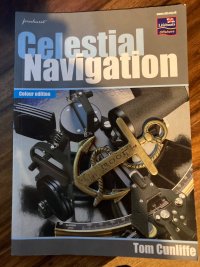I would comment on your post, Oz
However long it has been since your last dabble, the process is the same...as is the satisfaction of a result just as valid as ever it was....more so, in that any land based Observers can easily check their accuracy offset and compare it against known data.
Yes, a well calibrated instrument is a necessity if an accurate result is the aim
At Sea, the most common errors of the actual altitude measurement, aside of the 3 adjustable errors, were due to a vessel movement , rolling, that changed the value of the correction for height of eye. There was also the uncertainty of just where the horizon was....I know it sounds weird, but the truth is that the effect of refraction is rarely the same all around the horizon. Mostly, this factor was assessed via one of the many bog-standard formulae....but we never knew for sure .
The Math/Trig and its process, were more than sufficient to deal with sextant measurements and any permanent scale error...it should be remembered that Marine Celestial Nav was essentially an ocean-passage navigation system and was "capable" to a seamanlike degree........However, the one big limitation was the necessity of having a clear view of the heavenly body and also the need of a clear Horizon, though through the use of a Wrinkle, a suitable horizon could sometimes be accounted...
Land based use of a standard sextant, was used for many years by the various Surveyors and Explorers of old. And, today, with our modern timepieces, we can be absolutely certain of out time quotient , in a way that the Old Un's could not. This means that modern, land based Ob's can be a good deal more accurate, saving the ever present problem of atmospheric refraction.
From my own Ob's's, I have detected changes, in my local refraction and the causes are many...f'r instance,a measure taken over a sight-line over a roof top or a tree in leaf, can be variable in its effect on results...and can change seasonally.
For land based stuff, an artificial Horizon is easily 'fabbed'-up, using a dish of water under a protecting tent of glass.
Conversely, a good thickness ,plane surface mirror can be levelled as evidenced by up-market spirit levels and used for the same thing...........levelling it can still be a pain in the proverbial.
Both these methods work extremely well and , besides wooly error of refraction, the only downside is the tendency to a thermal rolling of the water medium, or other liquid.....(I personally use a modern creosote) which can slightly distort the lower image.
Incidentally , I watched the whole of the recent Rogue Hero's...hoping to see sight of re-enactment of the CelNav that they used.......which would have been , at best, a Tavistock Theodolite. These, having a fitted levelling system, would be used to measure Stars/Planets, Not an altitude to any horizon, but , the dead opposite of the altitude i.e they , having found the local vertical, could measure from their Zenith Point, downward to the object being, 'taken'. For the calculation, I wouldn't be in the least surprised if they used the cylindrical, Bygrave slide rule ...which was equivalent to a slide rule of around 40 feet long.
Anyhow, I have managed to alert myself to the fact that I have been 'waffling-on' about my favourite Hobbyhorse.
Can't help it, I'm afraid, always was a bit of a stargaser.
Rgds All
Ceeg

